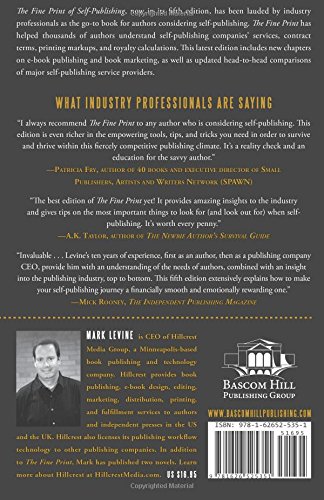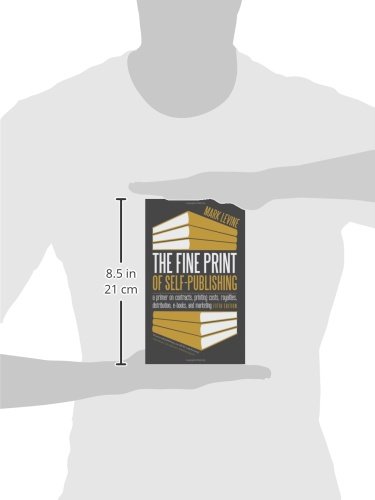Customer Services
Copyright © 2025 Desertcart Holdings Limited
Desert Online General Trading LLC
Dubai, United Arab Emirates




The Fine Print of Self-Publishing: A Primer on Contracts, Printing Costs, Royalties, Distribution, E-Books, and Marketing
K**N
Useful charts
There's some useful advice in the book, but there is a tendency to repeat information several times, and the effect is that it comes across a little too much like a self-help book rather than a manual for publishing. There's a discussion on the differences between print-on-demand (POD) and short-run publishing, a discussion of the differences between PDFs and ebooks, and other useful things to know.As the cover says, this is a primer and the author does not go into a lot of detail on the actual production of getting a manuscript ready (writing, editing, typesetting, layout, graphic design, cover design). Use this as a first book, then follow up with more specific books on aspects of book publishing that you need to know.I have 30+ years in the printing and publishing industry. I was mostly looking for information about royalties, distribution, and marketing, as well as some legal specifics. The book has appendices covering standard book sizes you're likely to find offered at POD companies, as well as a self-publishing checklist and information on what to ask a self-publishing company. Much of this assumes you are not going to do your own production of print-ready files, so having an idea of what you should ask a potential freelancer or publisher is very helpful.One thing bugged me: the author specifically advised against making wide margins on your pages so that it looks like you're just trying to pump up the size of your book and YET ... this book uses large amounts of leading (space between lines of text) that does puff up the size of this book. It could have been cut by a quarter to a third of the number of pages. Okay, that's my rant. Don't get stingy on your margins: readers need to be able to hold a book without their thumbs covering up the words, and text that runs into the center of the book (known as the gutter) is difficult to read.While the pricing charts are useful, I would have preferred the use of endnotes rather than footnotes because this would have kept the charts from breaking across so many pages, which hinders readability. The author has a "thing" about printing markups and really delves into this area. There are companies who will cream off as much money from you as they can, and you need to be an intelligent print buyer, but printing companies must make a profit to survive. Mark Levine does give you some tools to help determine if you're paying a good price or getting ripped off.
L**N
An absolute must for authors seeking publication
I am an author who was flailing about among the bezillion self-publishing outfits and got to Mark Levine's book via an internet search. As I am seeking to publish my second novel, I am very familiar with the dire expectations of self-publishing to even make one's money back. Thus I found Levine's book to be a refreshing, albeit bracing, explication of the many variables in play in the "self-" and "traditional" worlds of publishing, both print and e-books--which I had never understood in getting my first novel published by a small independent press. Several take-homes: Have your book professionally edited. Think about who your target readers are and begin thinking about how to market to them. Look at his book to find out what makes a good self-pub outfit vs one who pressures or flatters you into a package before you've gut-checked your expectations and really done your homework as to what you can afford, both in outlay of money and of time. Biggest clarification for me: Pay now or pay later. Though oversimplified, this means self-pub outfits (the good ones) get your money for getting your work out there, but you get relatively more of the royalties (with a good company). Traditional publishers absorb the production costs, but take the lion's share of royalties--and even with them (unless you're J.K. Rowling) YOU do the post-publishing marketing on your dime.If you have a fiction or non-fiction manuscript nearing readiness for the published page, get this book.
M**N
Contains a Lot of Info That Publishing Companies Don't Want Self-Published Authors To Know About
This book contains a ton of info that publishing companies do not want self-published authors to be aware of. As a self-published author myself, I can say that this book will save so many self-published authors a huge amount of money, time, and aggravation. Any self-published author considering using any publishing company such as CreateSpace, Lulu, LSI, AuthorHouse, etc. etc., should read this book before doing anything else. Mark Levine details what to look for in publishing companies and their contracts. Even more valuable, he does a thorough investigation of each major publishing company. He does all of the investigation work that most authors wouldn't even know where to begin. He is able to because he is an attorney in the publishing field and also runs a publishing company. I participate in a number of LinkedIn discussion groups related to the topic of self-publishing. Quite often discussion questions are posed by group members asking what have been the experiences of other group members with other publishing. I have yet to hear a reply as complete as the information about the pros and cons of each company in this outstanding book. When I read this book, I was very surprised at how much I didn't know. Every self-published author absolutely should read this landmark book.
M**H
It is better to confront that reality before spending any money
This book is extraordinarily helpful. It is a very truthful, unvarnished look at the self-publishing industry, its limitations, and its potential for an author who is committed to producing a book the correct way. Reading it, I often felt discouraged about my prospects, but that is simply the reality that an indie writer faces. It is better to confront that reality before spending any money.This book does include a lot of charts, and if you are someone who likes to look at and understand charts, I would suggest that you purchase the print version of this book. The Kindle version does not make them easy to look at.If you think you want to self-publish your book, read The Fine Print of Self-Publishing first.
R**R
Terribly disappointed with this book
If you're looking for a "Dummies" intro to self-publishing buy this book now. Don't even think twice!!! If, on the other hand, you, like me, are after something more advanced then leave this one on the bookshelf. I've seen more "Fine Print" on toilet paper. I'm pretty new to this business and have only been actively researching the subject for about 2 weeks. I naively imagined that this book would advance my knowledge no end. I was sadly disappointed.
M**Y
Five Stars
Very helpful
B**W
If you're even thinking of self-publishing, you need to buy this book.
When I learned that this edition followed a different format than the 4th, I admit I was worried since I'd found the 4th Edition to be so useful and informative. It didn't take long for that concern to evaporate.Knowing the key areas to assess within publishing companies and having the tools to assess them on your own is extremely valuable, especially with the rate at which the market is expanding and evolving. It's also useful to me as a Canadian because I can now apply those tools and criteria to some Canadian companies.I found the book to be well-organized and easy to read. It will save you hours of your own research, and hours of frustration when you do your own research because it makes very clear the questions you need to ask. It answered questions I didn't even know I needed to ask, and made me think about things I hadn't considered, including the specifics of my marketing plan (or, perhaps more accurately, my lack thereof).If you can only afford to buy one book on self-publishing, this is the one.
B**N
Great Review of Self-Publishing Ins and Outs
I'd heard about this book from my book editor and found The Fine Print of Self-Publishing very helpful in reviewing many of the current options available. The book offers the nitty gritty details of costs and royalties and compares and categorizes each company, making it easier for the author to choose from an educated place. A great book for any author looking at self-publishing as the way of getting their book out into the world.
Trustpilot
4 days ago
3 weeks ago